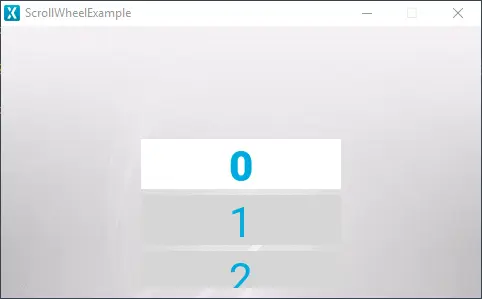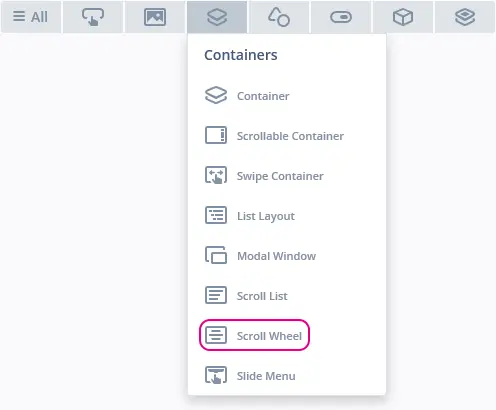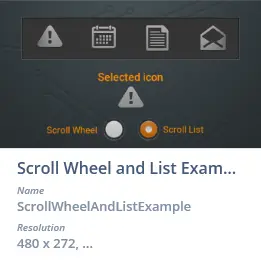滚轮
滚轮是包含多个项目的可滚动菜单,滚动浏览菜单中的项目时,这些项目会动态更新,且被选中的项目将突出显示。 启用响应与滚轮交互的代码后,可基于与轮中项目的交互调用不同的回调函数。
控件组
滚轮位于TouchGFX Designer中的容器控件组中。
属性
TouchGFX Designer中滚轮的属性。
| 属性组 | 属性说明 |
|---|---|
| 名称 | 控件的名称。 名称是TouchGFX Designer和代码中使用的唯一标识符。 |
| 类型 | 类型指定滚轮方向为垂直方向或水平方向。 |
| 位置 | X 和Y 指定控件左上角相对于其父的位置。 W 和 H 指定控件的宽度和高度。 锁定指定控件是否应锁定为其当前的X、Y、W和H。 如果锁定控件,还会禁止通过屏幕与控件进行交互。 可见 指定控件的可见性。 如果将控件标记为不可见,还会禁止通过屏幕与控件进行交互。 |
| 项目模板 | 项目模板 指定用作模板的CustomContainer。 选项数 指定滚动列表中存在的项目数。 首选项目 指定首先选择哪个项目。 使用已选样式模板 指定是否为所选项目使用单独的模板。 已选样式模板 指定用作选定模板的CustomContainer。 |
| 列表外观 | 循环 指定到达列表末尾后,滚轮中的项目是否将循环。 选中项偏移量 指定选定项目的位置。 项目边距 指定项目之间的间距。 前方额外尺寸和后方额外尺寸 指定显示已选样式模板的区域的大小。 前边距和后边距指定显示已选样式模板的区域前后的边距大小。 |
| 动画 | 缓动和缓动选项指定动画使用的缓动方程。 Swipe Acc. 和 Drag Acc. 指定滚动时的加速度。 |
| Mixin | 可拖动 指定在运行时控件是否可拖动。 ClickListener 指定控件被点击时是否会调用回调函数。 MoveAnimator 指定控件是否可绘制 X 和 Y 值变化的动画。 |
项目模板
滚动列表中的项目基于名为“项目模板”的概念,项目模板属于CustomContainer,用作滚轮中各项目图形元素的基础。 为了突出显示所选项目,滚轮包含用于选择名为“已选样式模板”的项目模板的选项,已选样式模板仅可用于已选项目。 创建滚轮之前,应为项目模板以及已选项目模板(若启用)创建CustomContainer。
创建滚轮后,可在项目模板属性下选择CustomContainer。 为项目模板选择自定义容器时,会调整滚轮大小,以适应所选自定义容器不在可滚动方向上的的尺寸属性(垂直方向的宽度、水平方向的高度)。 更改其他尺寸属性(垂直方向的高度、水平方向的宽度)决定了可见的项目数。
交互
下面的部分介绍了滚轮支持的操作和触发条件。
操作
| 标准控件操作 | 说明 |
|---|---|
| 隐藏控件 | 隐藏控件(将可见性设置为false)。 |
| 显示控件 | 使隐藏的控件可见(将可见性设置为true)。 |
触发条件
滚轮不会产生任何触发条件。
性能
滚轮为Container类型,默认情况下不会出现在绘图链中。 因此,性能完全取决于控件的绘图性能。
更多关于绘图性能的信息,请阅读常规UI组件性能部分。
示例
生成代码
在生成的视图基类的代码中,可以查看TouchGFX Designer是如何创建滚轮的。
Screen1ViewBase.cpp
#include <gui_generated/screen1_screen/Screen1ViewBase.hpp>
#include "BitmapDatabase.hpp"
Screen1ViewBase::Screen1ViewBase() :
updateItemCallback(this, &Screen1ViewBase::updateItemCallbackHandler)
{
scrollWheel.setPosition(140, 10, 200, 252);
scrollWheel.setHorizontal(false);
scrollWheel.setCircular(false);
scrollWheel.setEasingEquation(touchgfx::EasingEquations::backEaseIn);
scrollWheel.setSwipeAcceleration(10);
scrollWheel.setDragAcceleration(10);
scrollWheel.setNumberOfItems(60);
scrollWheel.setSelectedItemOffset(100);
scrollWheel.setSelectedItemExtraSize(0, 0);
scrollWheel.setSelectedItemMargin(0, 0);
scrollWheel.setDrawableSize(50, 3);
scrollWheel.setDrawables(scrollWheelListItems, updateItemCallback,
scrollWheelSelectedListItems, updateItemCallback);
scrollWheel.animateToItem(0, 0);
add(scrollWheel);
}
void Screen1ViewBase::setupScreen()
{
scrollWheel.initialize();
for (int i = 0; i < scrollWheelListItems.getNumberOfDrawables(); i++)
{
scrollWheelListItems[i].initialize();
}
for (int i = 0; i < scrollWheelSelectedListItems.getNumberOfDrawables(); i++)
{
scrollWheelSelectedListItems[i].initialize();
}
}
void Screen1ViewBase::updateItemCallbackHandler(touchgfx::DrawableListItemsInterface* items, int16_t containerIndex, int16_t itemIndex)
{
if (items == &scrollWheelListItems)
{
touchgfx::Drawable* d = items->getDrawable(containerIndex);
TextContainer* cc = (TextContainer*)d;
scrollWheelUpdateItem(*cc, itemIndex);
}
else if (items == &scrollWheelSelectedListItems)
{
touchgfx::Drawable* d = items->getDrawable(containerIndex);
TextCenterContainer* cc = (TextCenterContainer*)d;
scrollWheelUpdateCenterItem(*cc, itemIndex);
}
}
Tip
请必须调用scrollWheel.invalidate ()强制进行重新绘制。用户代码
设置完滚轮的图形元素及其属性后,可编写用户代码更新滚轮中的项目。 The header file for the Screen1ViewBase class which is generated by TouchGFX Designer is shown below:
Screen1ViewBase.hpp
class Screen1ViewBase : public touchgfx::View
{
public:
Screen1ViewBase();
virtual ~Screen1ViewBase() {}
virtual void setupScreen();
virtual void scrollWheel1UpdateItem(CustomContainer1& item, int16_t itemIndex)
{
// Override and implement this function in Screen1
}
virtual void scrollWheel1UpdateCenterItem(CustomContainer2& item, int16_t itemIndex)
{
// Override and implement this function in Screen1
}
protected:
FrontendApplication& application() {
return *static_cast<FrontendApplication*>(Application::getInstance());
}
touchgfx::BoxWithBorder boxWithBorder1;
touchgfx::ScrollWheelWithSelectionStyle scrollWheel1;
touchgfx::DrawableListItems<CustomContainer1, 6> scrollWheel1ListItems;
touchgfx::DrawableListItems<CustomContainer2, 2> scrollWheel1SelectedListItems;
private:
void updateItemCallbackHandler(DrawableListItemsInterface* items, int16_t containerIndex, int16_t itemIndex);
touchgfx::Callback<Screen1ViewBase, DrawableListItemsInterface*, int16_t, int16_t> updateItemCallback;
};
When TouchGFX Designer generates the code for Scroll Wheel, the functions scrollWheel1UpdateItem and scrollWheel1UpdateCenterItem, highlighted above, is created for the user to override and update the items in the Scroll Wheel.
始终会为滚轮生成 UpdateItem 函数,并可实现该函数以更新包含的项目, UpdateCenterItem 函数会基于已选样式模板更新项目,因此,仅当选择使用已选样式模板时,才会生成此函数。 除了更新不同项目之外,这两个函数还包含相同的参数,用于更新滚轮中的项目。
参数 itemIndex 包含项目的索引值,该值用于标识正在更新的项目。 参数 item 是对滚轮中的可见项目的引用。 更新参数 item 的外观会更新为滚轮中可见项目的渲染。
下文给出了在用户代码文件 Screen1View.hpp 和 Screen1View.cpp 中实现 scrollWheel1UpdateItem 和 scrollWheel1UpdateCenterItem 的示例:
Screen1View.hpp
#ifndef SCREEN1_VIEW_HPP
#define SCREEN1_VIEW_HPP
#include <gui_generated/screen1_screen/Screen1ViewBase.hpp>
#include <gui/screen1_screen/Screen1Presenter.hpp>
class Screen1View : public Screen1ViewBase
{
public:
Screen1View();
virtual~Screen1View() {}
virtual void setupScreen();
virtual void tearDownScreen();
virtual void scrollWheel1UpdateItem(CustomContainer1& item, int16_t itemIndex);
virtual void scrollWheel1UpdateCenterItem(CustomContainer2& item, int16_t itemIndex);
protected:
};
#endif // SCREEN1_VIEW_HPP
Screen1View.cpp
#include <gui/screen1_screen/Screen1View.hpp>
Screen1View::Screen1View()
{
}
void Screen1View::setupScreen()
{
Screen1ViewBase::setupScreen();
}
void Screen1View::tearDownScreen()
{
Screen1ViewBase::tearDownScreen();
}
void Screen1View::scrollWheel1UpdateItem(CustomContainer1& item, int16_t itemIndex)
{
item.setIndex(itemIndex);
}
void Screen1View::scrollWheel1UpdateCenterItem(CustomContainer2& item, int16_t itemIndex)
{
item.setIndex(itemIndex);
}
在头文件Screen1View.hpp中,会覆盖scrollWheel1UpdateItem 和 scrollWheel1UpdateCenterItem函数,然后在Screen1View.cpp中实现该函数。
本示例的目标是更新具有可见项目索引值的项目模板中的文本,与本部分开头给出的示例相似。 由于项目模板和所选样式模板均基于CustomContainer,因此会为这两个CustomContainer创建 setIndex 函数。 setIndex 函数能够获取 itemIndex 参数并更新项目模板和所选样式模板中的文本。 为项目调用 setIndex 会更新可见项目的外观,从而会显示其索引值。
TouchGFX Designer示例
如需进一步了解滚轮,请尝试在TouchGFX Designer中使用下列UI模板之一创建新应用:


